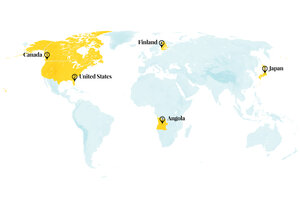Lifesaving changes: From demining Angola to calming traffic in Japan

1. Canada
Chopsticks are proving that a circular business can be created from single-use products. The idea for a sustainable home furnishings company came to engineer Felix Böck after he had just given a seminar on sustainability in Vancouver, British Columbia, and a waiter threw away his chopsticks at a sushi restaurant. “Suddenly, I understood that I had to show people how circular economy works instead of just talking about it,” Mr. Böck said. He began his startup, called ChopValue, creating coasters and cutting boards from disposed chopsticks, which are usually made of bamboo. Since then, the company has grown to a staff of 35 people; the team collects 350,000 chopsticks from restaurants in Vancouver each week – 70 million in total across its operations so far.
The chopsticks are treated with high heat and pressure at franchise microfactory locations from Liverpool to Bali to create products like shelves, desks, wall panels, and stairs. On its own, ChopValue will not make a dent in the global trash problem. But if other businesses follow suit, the effects could ripple. Mr. Böck’s hope is that “every city adopts the concept of urban recycling instead of just transporting their trash out of town and say[ing], great, now we’re done. ... Because trash is never gone.”
Source: Reasons to be Cheerful
2. United States
Nicole Mann became the first Native American woman in outer space. NASA’s SpaceX Crew-5 mission launched Oct. 5 from Florida’s Kennedy Space Center. With Colonel Mann as commander, the crew will spend five months on the International Space Station. Colonel Mann is a member of the Wailacki, one of the Round Valley Indian Tribes. She has served over two decades in the U.S. Marine Corps, which includes 47 combat missions in Afghanistan and Iraq. She joined NASA in 2013.
Why We Wrote This
Our progress roundup looks at big problems with multifaceted solutions that also yield multiple positive effects. In Angola, teams of women are removing land mines to make places safe again. And in Japan, everything from better train service to tiny cars has reduced traffic fatalities.
Despite Colonel Mann’s success, structural barriers persist for young Indigenous Americans. As of last year, 24% of Native American 18- to 24-year-olds were enrolled in college, as compared with 41% of the general population. Colonel Mann said she hopes her journey leaves a mark on young observers from disadvantaged backgrounds: “[I hope it] will inspire young Native American children to follow their dreams and realize that some of those barriers that are there or used to be there are being broken down.” Colonel Mann is also the first female commander of a SpaceX mission.
Sources: Smithsonian, BBC, Postsecondary National Policy Institute
3. Angola
Angolan women are demining their country, breaking down stereotypes while earning a stable living. Three decades of civil conflict between 1975 and 2002 left some 73 million square meters (18,000 acres) of Angola contaminated by land mines, which continue to claim lives and stifle agriculture and development. While the job of demining was once assumed too dangerous and demanding for women, the HALO Trust launched an initiative in 2017 to recruit 100 female deminers in Angola. Today, close to 400 women have answered the call, with several dozen more in training.
The work of detecting and deactivating mines is challenging, with days starting at 4:50 a.m. and visits home just once a month. But the steady income of $350 goes a long way in a country with an average monthly income of around $35, according to 2018-19 data. So far only a fraction of the contaminated land has been cleared, though deminers are making progress. The province of Huambo, once one of the most heavily mined areas of the country, was fully cleared of minefields in 2021. “Every time we destroy a mine I feel proud,” says deminer Cecilia Manuel. “When you take away the mines, you make the people free.”
Sources: NPR, Mines Advisory Group
4. Finland
The world’s first “sand battery,” capable of storing green power for months at a time, is up and running in Finland. One obstacle to year-round renewable power is the difficulty of capturing and storing energy when intermittent sources like wind or solar energy are unavailable. Finnish engineers at Polar Night Energy have employed a solution in a simple material: low-grade sand.
The battery they devised involves a tank measuring 13 by 23 feet, filled with 100 metric tons of sand, for 100 kW heating power and 8 MWh capacity. Solar or wind energy is converted into hot air, which keeps the sand at a temperature of 500 degrees Celsius (932 degrees Fahrenheit). For the town of Kankaanpää, that heat warms water that is then pumped to local buildings via a district heating network, serving some 10,000 people.
Unlike expensive lithium batteries, which leave a considerable physical footprint, the sand battery has a minimal environmental footprint. Developers say the design won’t be affected by sand shortages in the glass and concrete industries because the technology uses low-grade sand or sandlike materials.
Sources: Dezeen, BBC
5. Japan
The number of annual traffic fatalities in Japan is 16% of what it was half a century ago. Since their peak in 1970, when 16,765 people died in collisions, deaths caused by road accidents have declined steadily in Japan. The 2021 total was the lowest on record, lower even than when data collection began in 1949 – a per capita rate that is less than a fifth of the rate in the United States.
The late 1960s became known in Japan as the “traffic war,” prompting a government response that spanned regulations, law enforcement, education, and vehicle safety standards. Since then, improvements in rail travel and deterrents to driving such as prohibitions on street parking have shifted consumer preference away from cars. The average Japanese drives a third as much as the average American. Meanwhile, microcars, whose compact designs reduce blind spots and generate less force in collisions, make up a third of new cars sold in Japan.
Sources: Bloomberg, The Asahi Shimbun, Journal of the International Association of Traffic and Safety Sciences

